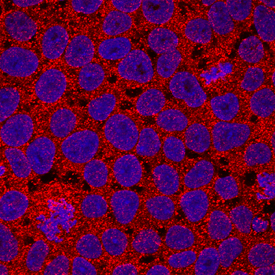Human/Primate Cripto-1 Antibody Summary
Arg38-Tyr188
Accession # P13385
Applications
Human/Primate Cripto-1 Sandwich Immunoassay
Please Note: Optimal dilutions should be determined by each laboratory for each application. General Protocols are available in the Technical Information section on our website.
Scientific Data
 View Larger
View Larger
Cripto-1 in Human iPSCs. Cripto-1 was detected in immersion fixed human induced pluripotent stem cells (iPSCs) using Mouse Anti-Human/Primate Cripto-1 Monoclonal Antibody (Catalog # MAB2772) at 20 µg/mL for 3 hours at room temperature. Cells were stained using the NorthernLights™ 557-conjugated Anti-Mouse IgG Secondary Antibody (red; Catalog # NL007) and counterstained with DAPI (blue). Specific staining was localized to cytoplasm. View our protocol for Fluorescent ICC Staining of Stem Cells on Coverslips.
 View Larger
View Larger
Detection of Cripto-1 in BG01V Human Cells by Flow Cytometry. BG01V human embryonic stem cells were stained with Mouse Anti-Human Cripto-1 Monoclonal Antibody (Catalog # MAB2772, filled histogram) or isotype control antibody (MAB002, open histogram) followed by anti-Mouse IgG APC-conjugated Secondary Antibody (F0101B). Staining was performed using our Staining Membrane-associated Proteins protocol.
Reconstitution Calculator
Preparation and Storage
- 12 months from date of receipt, -20 to -70 °C as supplied.
- 1 month, 2 to 8 °C under sterile conditions after reconstitution.
- 6 months, -20 to -70 °C under sterile conditions after reconstitution.
Background: Cripto
Cripto is the founding member of the epidermal growth factor-CriptoFRL1Cryptic (EGF-CFC) family of signaling proteins that function in cancer and various developmental processes. These developmental processes include: formation of the germ layers and dorsal organizer, specification of anterior-posterior and left-right axes, and differentiation of heart muscle (1, 2). Other members of the EGF-CFC family include Cryptic, Xenopus FRL-1 and zebrafish OEP (one-eyed pinhead). Overall sequence identity between members of the family is low, but they do share several common domains: a variant EGF-like motif, a novel conserved
cysteine-rich domain (called CFC domain), and a C-terminal hydrophobic region. Most EGF-CFC members have a glycosyl-phosphatidylinositol (GPI) anchoring site at the C-terminus and exist as extracellular membrane-anchored proteins. However, naturally-occurring soluble isoforms also exist. Human Cripto shares 66% and 28% amino acid identity with mouse Cripto and zebrafish OEP, respectively (2). Despite weak conservation in amino acid identity, EGF-CFC family members appear to function similarly in assays for phenotypic rescue of zebrafish oep mutants (2). Both secreted and membrane bound forms of Cripto demonstrate biological activity (3). Cripto, also known as CFC-2 or TDGF-1 (teratocarcinoma-derived growth factor), was originally isolated from an undifferentiated human teratocarcinoma cell line as a potential oncogene. It is overexpressed in many types of cancers and acts as a growth factor for tumors (4). Genetic evidence from mice and zebrafish points to a role for Cripto as an essential cofactor in Nodal signaling. Cripto and OEP mutants display defects in mesoderm induction and heart morphogenesis, similar to phenotypes seen in Nodal mutants (2).Cripto acts as a cofactor for Nodal by recruiting the Activin type I Receptor, ALK-4, leading to an
Act RIIB-ALK4-Cripto-Nodal complex for signaling (1, 3). Cripto also forms a complex with activin and Act RIIs to block activin signaling (5). Studies have shown that other TGF-beta superfamily members such as Vg1 and GDF-1 also require EGF-CFC cofactors (6). Cripto can also activate mitogen-activated protein kinase (MAPK) and Akt pathways independently of Nodal by directly binding to a membrane-associated heparan sulfate proteoglycan, glypican-1 (7).
- Rosa, F.M. (2002) Science’s STKE http://stke.sciencemag.org/.
- Shen, M. and A. Schier (2000) Trends Genet. 16:303.
- Yan, Y-T. et al. (2002) Mol. Cell Biol. 22:4439.
- Salomon, D. et al. (2000) Endocrine-Rel. Cancer 7:199.
- Gray, P.C. et al. (2003) Proc. Natl. Acad. Sci. USA 100:5193.
- Cheng, S. et al. (2003) Genes & Dev. 17:31.
- Bianco, C. et al. (2003) Cancer Research 63:1192.
Product Datasheets
Citation for Human/Primate Cripto-1 Antibody
R&D Systems personnel manually curate a database that contains references using R&D Systems products. The data collected includes not only links to publications in PubMed, but also provides information about sample types, species, and experimental conditions.
1 Citation: Showing 1 - 1
-
Dynamic regulation of the cancer stem cell compartment by Cripto-1 in colorectal cancer.
Authors: Francescangeli F, Contavalli P, De Angelis M, Baiocchi M, Gambara G, Pagliuca A, Fiorenzano A, Prezioso C, Boe A, Todaro M, Stassi G, Castro N, Watanabe K, Salomon D, De Maria R, Minchiotti G, Zeuner A
Cell Death Differ, 2015-03-20;22(10):1700-13.
Species: Human
Sample Types: Cell Culture Supernates
Applications: ELISA Development (Capture)
FAQs
No product specific FAQs exist for this product, however you may
View all Antibody FAQsReviews for Human/Primate Cripto-1 Antibody
There are currently no reviews for this product. Be the first to review Human/Primate Cripto-1 Antibody and earn rewards!
Have you used Human/Primate Cripto-1 Antibody?
Submit a review and receive an Amazon gift card.
$25/€18/£15/$25CAN/¥75 Yuan/¥2500 Yen for a review with an image
$10/€7/£6/$10 CAD/¥70 Yuan/¥1110 Yen for a review without an image


